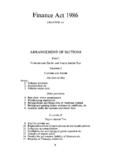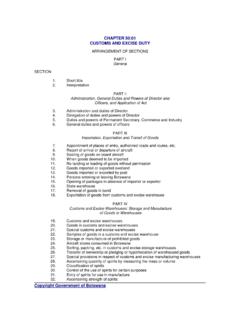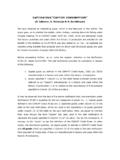Transcription of Musonda Kabinga, Aaron Yambani SJ Zambia VI: Tax ...
1 Draft version, not yet officially authorized for quoting. 1 Musonda Kabinga, Aaron Yambani SJ Zambia VI: Tax administration Compiled and ordered material, prepared for future use. With contributions by Andrew Simpasa SJ and J rg Alt SJ Joerg [W hlen Sie das Datum aus] Draft version, not yet officially authorized for quoting. 2 Inhalt List of graphics .. 3 List of tables .. 4 1 Introduction: Structure of Zambia Revenue Authority .. 4 2 ZRA Workforce and performance .. 6 The situation .. 6 Quantitative problems: Staff shortage .. 8 Qualitative problems: Staff training .. 9 3 Modernization efforts & ICT .. 9 Reasons .. 9 Departments and instruments .. 9 Customs & Excise .. 9 Tax Online .. 10 Enterprise Risk Management System .. 10 Data bases and data exchange .. 11 Problems .. 11 Conclusion .. 12 4 Efforts to improve compliance .. 12 Registration .. 12 Advice Services .. 13 Audits .. 14 Block Management System .. 16 Mineral Value Chain Monitoring Project.
2 16 Other Compliance Initiatives .. 17 5 Enforcement deficits .. 17 Categories of tax avoidance and tax evasion .. 17 Deficits in taxing PAYE and mixed-income .. 18 General taxation of businesses .. 19 The taxation of corporate income .. 19 Transparency Corporate Veil .. 21 Specific taxation of MNCs .. 21 Transfer Pricing .. 22 Draft version, not yet officially authorized for quoting. 3 Under-reporting values, over-reporting costs .. 22 Debt payment abuse .. 23 Hedging manipulation .. 23 Conclusion .. 23 Parastatals .. 24 Taxing the informal sector .. 24 The situation .. 24 Specific problems .. 25 Collecting tax from real property .. 26 6 Collection of debt .. 27 7 Investigation and prosecution .. 28 8 Data leaks .. 28 9 Assistance by and cooperation with other 28 10 Outside influence due to political interests .. 29 11 Discussion .. 31 Voluntariness or Control? .. 31 Costs of tax collection and justice issues .. 32 Survey on taxpayers view of ZRA.
3 33 12 Mandatory Social Security Contributions .. 35 13 Conclusion .. 35 14 Annex 1: ZRA Governing Board, Committees, Departments and divisions .. 37 15 Literaturverzeichnis .. 40 List of graphics Graphic 1 Organogram of ZAR .. 5 Graphic 2 Processing efficiency in Tax Yield from all taxable transactions (K'million) .. 11 Graphic 3 Number of TPIN registrations 12 Graphic 4 Contact with Advice Centre 2014 .. 13 Graphic 5 Factors influencing tax compliance .. 31 Graphic 9 Withholding Tax as Percentage of GDP, 1995-2014 .. 32 Draft version, not yet officially authorized for quoting. 4 Graphic 6 Taxpayers satisfaction with ZRA staff work performance .. 33 Graphic 7 Taypayers satisfaction with Tax Online and Advisory Services 34 Graphic 8 Overall assessments: Did recent innovations make taxpaying more simple? .. 34 List of tables Table 1 Staff Classification as operations and support 2013/2014 .. 6 Table 2 Separations recorded 2013/2014 .. 8 Table 3 Enforcement outcomes 2014.
4 10 Table 4 Outreach activities .. 13 Table 5 Number of audits and tax collected in 2014 .. 14 Table 6 Total debt stock 2010-2014 .. 27 Table 7 Trends in domestic debt accumulation 2010-2014 .. 27 1 Introduction: Structure of Zambia Revenue Authority As explained in , the collection of taxes, levies, fees, duties etc. is a shared undertaking by the Zambia Revenue Authority (ZRA), municipal bodies and specially commissioned agents. Of those, ZRA is by far the largest and most important institution. The ZRA was established on 1st April 1994 as a corporate body, under the Zambia Revenue Authority Act, Chapter 321 of the Laws of Zambia enacted in 1993. Pursuant to this Act, the Authority is charged with the responsibility of collecting revenue on behalf of the Government of the Republic of Zambia under the supervision of the Minister of Finance. The Operations of ZRA are overseen by the Governing Board. The membership of this Board as provided for in the Act includes; the Secretary to the Treasury, the Permanent Secretary Ministry of Justice; the Governor of the Bank of Zambia ; representatives from the Law Association of Zambia ; the Zambia Association of Chambers of Commerce and Industry, the Bankers Association of Zambia , the Zambia Institute of Chartered Accountants; and two other members appointed by the Minister of Finance.
5 The Chairman of the Board is elected from amongst its members. Draft version, not yet officially authorized for quoting. 5 The Chief Executive Officer of the ZRA is the Commissioner General who is appointed by the President of the Republic of Zambia without parliament having a say in Graphic 1 Organogram of ZAR Source 1 ( Zambia Revenue Authority, 2015, p. 11) The ZRA has two divisions that are mandated to collect tax revenue which are Customs Services Division and Domestic Taxes Division and are of specific interest for this report: Customs Services The Division is responsible for the administration of the Customs and Excise Act Chapter 322 of the Laws of Zambia . In addition, the Division is also responsible for securing the supply chain, protection of society through the control of imports of prohibited substances and the provision of trade statistics. The Division also facilitates international trade. Taxes 1 Zambia Revenue Authority (ZRA).
6 Retrieved April 25, 2015 from Draft version, not yet officially authorized for quoting. 6 administered by the Division are; customs duties, export duties; excise duties; import VAT; motor vehicle fees and carbon emissions surtax. Domestic Taxes The Division is responsible for the administration and collection of all domestic taxes apart from domestic excise duty that is collected by Customs Services Division. The Division administers the Income Tax Act, Chapter 323 of the Laws of Zambia ; the Value Added Tax Act, Chapter 331 of the Laws of Zambia ; the Property Transfer Tax Act, Chapter 340 of the Laws of Zambia ; and the Medical Levy Act, NO. 6 OF 2003. In addition, the Division collects mineral royalty pursuant to the Mines and Minerals Development Act, No. 7 of 2008. There are three directorates under Domestic Taxes Division namely; Design and Monitoring (D&M), Large Taxpayer (LTO) and Small and Medium Taxpayer office (SMTO). Taxpayer segmentation is according to the annual turnover; LTO ZMW 20million and above per annum, MTO- below ZMW 20million but above ZMW 200,000 per annum and STO ZMW 200,000 and below.
7 Despite this segmentation, all financial institutions and mining companies (including small and medium mines) regardless of the turnover are classified under LTO. A specialized Mining Unit under LTO is responsible for all mining tax affairs. For more details, also on other departments, see Annex 1 to this chapter. 2 ZRA Workforce and performance The situation Divided into the operational and support segment, the staff distribution 2013/2014 is as follows: Table 1 Staff Classification as operations and support 2013/2014 Draft version, not yet officially authorized for quoting. 7 Source 2 ( Zambia Revenue Authority, 2015, p. 46) In 2012, the ZRA had a total staff complement at 1,355 out of the approved 1,482 staff needed. This shows a deficit of 127 staff. In Core Divisions such as Domestic Taxes out of the approved staff establishment of 438, they were 404 staff. Further, in Customs Division they were 514 employees out of the approved 575 ( Zambia Revenue Authority, 2013, p.)
8 43). In 2013, there were 1,450 staff against the approved staff complement of 1,482 representing a deficit of 32 staff. In Domestic Tax Department/Division they were 426 staff out of the approved 434, while in Customs division they were 541 staff out of the approved 560 staff ( Zambia Revenue Authority, 2014, p. 50). In 2014 there were 1,439 staff against the approved staff of 1,557, the decrease to be explained due to a decrease in the net staff complement of Customs and Corporate services and Finance Division. ZRA has been implementing a Performance Management Development Contract. In 2012, of the workforce exceeded their performance, meet their targets and of the workforce did not meet their performance target. In 2013, of the employees exceeded their performance, met their target and did not meet their performance targets ( Zambia Revenue Authority, 2012+2014). Draft version, not yet officially authorized for quoting. 8 Quantitative problems: Staff shortage ZRA has competent personnel in most of the departments to preside over matters of taxation.
9 However, while there are all the relevant departments, divisions and qualified personnel, the question of an adequate number of personnel or staff to effectively implement departmental functions cannot be overlooked. In 2012, the ZRA had a total staff complement at 1,355 out of the approved 1,482 staff needed. This shows a deficit of 127 staff. In 2013, there were 1,450 staff against the approved staff complement of 1,482 representing a deficit of 32 staff. In 2014, the Board approved the increase of the staff establishment from 1,482 employees to 1,557 employees while the actual staff number declined from 1450 in December to 1439 as at the end of 2014 on account of attrition ( Zambia Revenue Authority, 2015, p. 5) In terms of the ratio per 1,000 taxpayers, there are only 2 ZRA staff which is the lowest among the three countries participating in this research Finally one should be mindful of separations from ZRA. An analysis of exit interviews conducted indicated that resignations are mainly as a result of career progression and better conditions of service offered elsewhere ( Zambia Revenue Authority, 2014, p.)
10 50). Table 2 Separations recorded 2013/2014 Source 3 ( Zambia Revenue Authority, 2015, p. 47) Robert Liebenthal the former Economics Association of Zambia (EAZ) Vice President and International Growth Centre (IGC) Senior Country Advisor argues that, collecting more tax revenue in Zambia especially from the mining sector will require the ZRA to employ more staff with experience . R. Liebenthal (Personal Communication, November 21, 2014). It is 2 Fjeldstad & Heggstad, 2011, p. x. Retrieved from Draft version, not yet officially authorized for quoting. 9 therefore necessary that the Authority has enough staff to in order to effectively collect taxes. It is imperative that the ZRA improves its conditions of service in order to retain staff key experienced and qualified staff. Qualitative problems: Staff training There is need for more training of tax administration staff to assist them in keeping abreast of legal developments and enhance their use of latest information technology.








